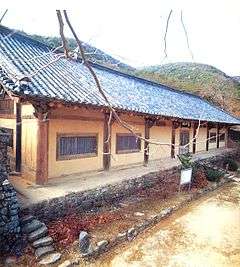Eunhaesa
| Eunhae Temple | |
|---|---|
|
Yeongsanjeon Hall of Geojoam Hermitage, National Treasure 14.[2] | |
 Eunhae Temple Location within South Korea | |
| Geography | |
| Coordinates | 35°59′31″N 128°47′23″E / 35.9920634°N 128.7896335°ECoordinates: 35°59′31″N 128°47′23″E / 35.9920634°N 128.7896335°E |
| Country | South Korea |
| Location | Chiil-ri, Cheongtong-myeon, Yeongcheon, North Gyeongsang Province |
| History and governance | |
| Website | eunhae-sa.org |
| Eunhaesa | |
| Hangul | 은해사 |
|---|---|
| Hanja | 銀海寺 |
| Revised Romanization | Eunhaesa |
| McCune–Reischauer | Ŭnhaesa |
Eunhaesa is a head temple of the Jogye Order of Korean Buddhism. It is located in Cheongtong-myeon, Yeongcheon, in the province of Gyeongsangbuk-do, South Korea. It stands on the eastern slopes of Palgongsan, not far from another major temple, Donghwasa. The temple was founded by National Preceptor Hyecheol in 809. The name means "temple of the silver sea." The original name was "temple of the tranquil sea," Haeansa. After the original temple burned to the ground following the Seven Year War in the 1590s, it was moved to its current location and named Eunhaesa.[3][4]
See also
References
- ↑ "Yeongsanjeon Hall of Geojoam Hermitage of Eunhaesa Temple in Yeongcheon". Cultural Heritage Administration. Retrieved 22 May 2013.
- ↑ "Yeongsanjeon Hall of Geojoam Hermitage of Eunhaesa Temple in Yeongcheon". Cultural Heritage Administration. Retrieved 22 May 2013.
- ↑ "Eunhaesa Temple on Palgongsan Mountain". KBS World. 2011-09-15. Retrieved 2014-05-09.
- ↑ "Eunhaesa". Korea Tourism Organization. Retrieved 2014-05-09.
External links
This article is issued from Wikipedia - version of the 12/3/2016. The text is available under the Creative Commons Attribution/Share Alike but additional terms may apply for the media files.
